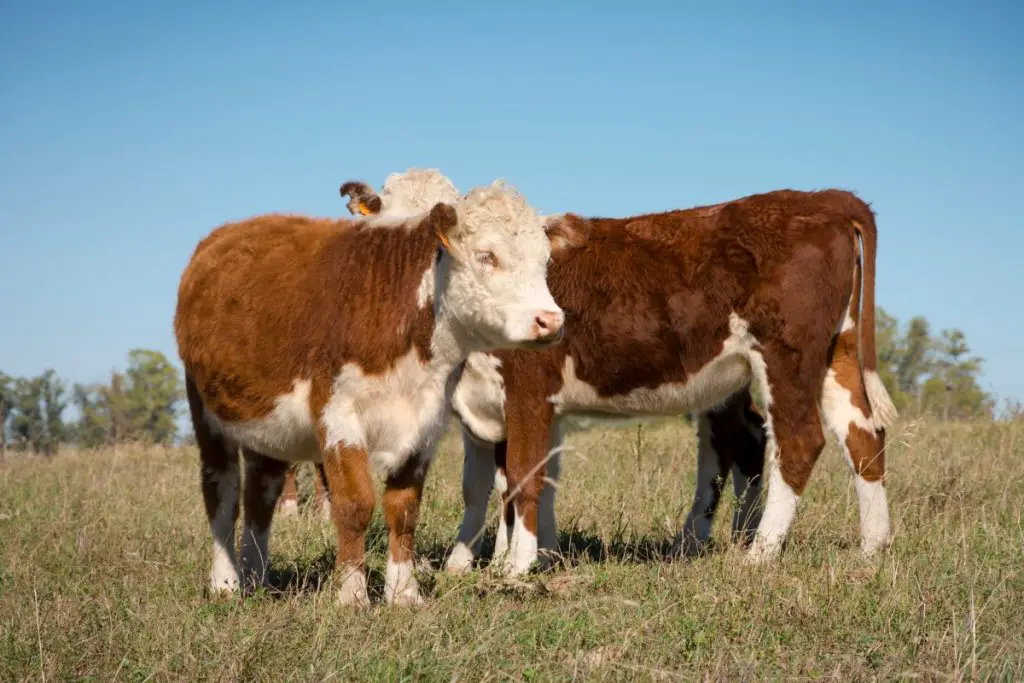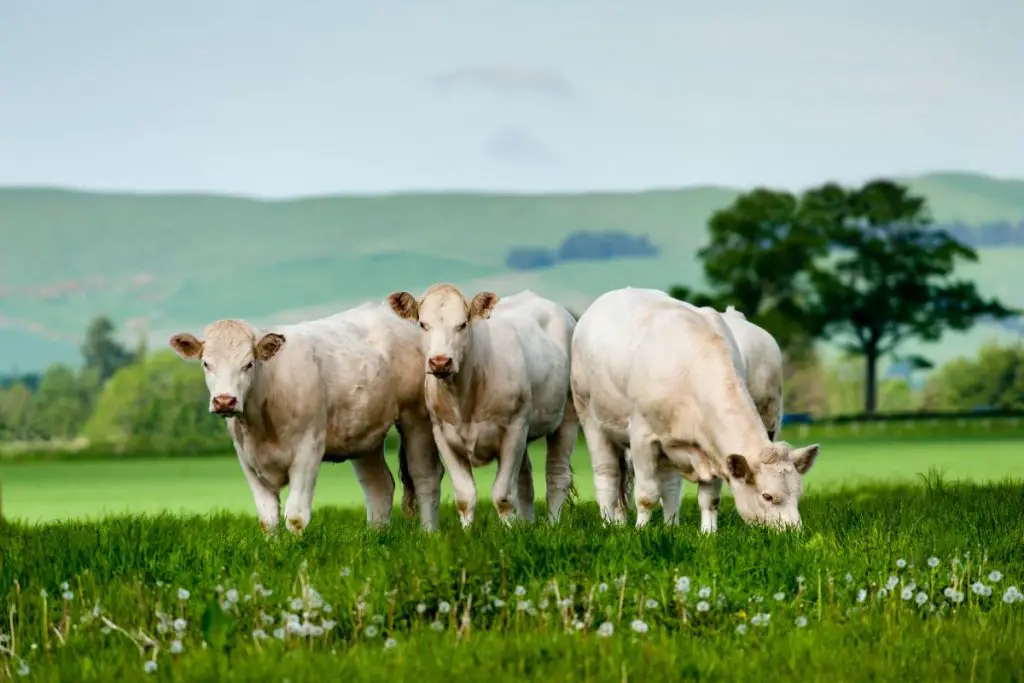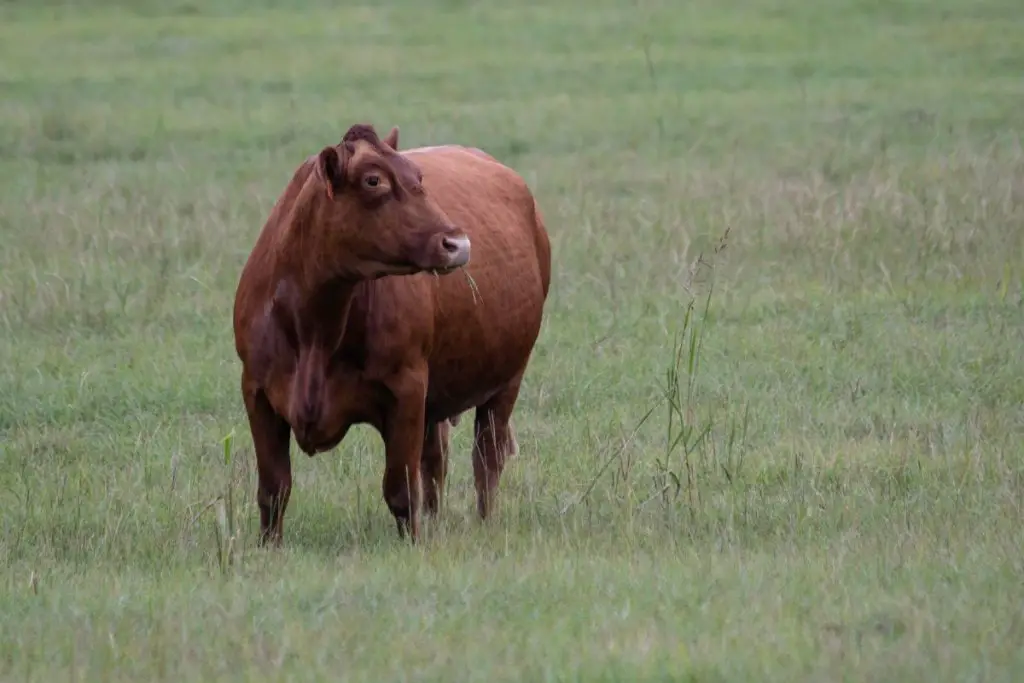The best cattle for grass fed beef are Angus, Red Devon and Hereford. These breeds are resilient, are nutrient-rich and can often be slaughtered within 2 years.
One of the most frequently asked questions from those interested in grass-based cattle genetics is, “What breed of cattle is the best for the production of grass-fed beef?”.
First of all, let’s see what the U.S. Department of Agriculture (USDA) says about grass-fed cattle:
“Grass- or forage-fed means that grass and forage are the feed source consumed for the entire lives of the ruminant animals, except milk consumed before weaning. The diet must consist solely of grass, forbs (e.g., legumes, Brassica), browse, or cereal grain crops in the vegetative (pre-grain) state.
You can’t feed cattle grain or related products. It is also a requirement that they have available pasture during the growing seasons.”
As a general rule of thumb, British breeds and crosses utilizing British breeds are the ones that are optimal for grass-fed beef production. However, other breed types will work just as well.
Let’s begin by determining the breed that would be the best fit for you. Locating local seedstock (breeding cattle) breeders that have been providing livestock for successful grass-fed beef programs will also give you a good indication of which breeds work the best in your area.
Let’s start with the three most popular breeds and finish with a few honorable mentions.
Table of Contents
1. Angus
The Aberdeen Angus, also known as the Angus, is a beef cattle breed from Scotland. Its origins are from cattle native to the counties of Aberdeenshire and Angus in north-eastern Scotland.

The twenty-first century British Angus cattle are the ultimate beef animal for purebred breeding and crossing with other beef breeds and millions of dairy cows worldwide.
Angus cattle first appeared in the U.S. on May 17th, 1873, when George Grant imported four bulls to Victoria, Kansas. Mr. Grant saw potential in the cattle even though many ranchers saw these polled beasts and dismissed them as “freaks.” He crossbred the bulls with Texas longhorn cows and produced a herd of black calves without horns that thrived on winter pasture.
Resiliency
The Angus crosses were more resilient to winter conditions and were consequently heavier the following spring – the first indication of this new breed’s value. The experiment made a positive impression on America’s cattle barons and inspired the importation and establishment of purebred herds. These herds came from 1,200 stock directly imported from Scotland to the Midwest between 1878 and 1883.
They calve easily and have shorter gestation in comparison to most breeds. British breeders have developed the strain to thrive on grass-based systems, live outside, and finish much younger than most other breeds.
Anguses are usually solid black, though the udder may be white. More recently, red examples have emerged, and the United States regards these as two separate breeds, although there is no distinction in the United Kingdom. The particular breed of Red Angus was created by selecting Anguses with a recessive red gene.
Nutrient-Rich and Good Marbling
The Black Angus is the most numerous pure breed of cattle in the U.S., with over 327,000 registered in 2018. The Aberdeen Angus breed came top of the British Cattle Movement Service 2021 list of registrations with no fewer than 471,528!
Their attributes include fast growth and high-quality, nutrient-rich meat with good marbling (flecks of fat within beef, making it tender and juicy). The dams are attentive and protective, make excellent mothers and produce a lot of milk for their calves.
Their strong maternal instincts mean they require very little attention when calving. Rates of dystocia or difficulties during labor are low. Angus and Angus-cross calves have excellent carcass characteristics and are consequently much sought-after by feedlot cattle buyers.
| Gender | Weight |
| Cows | around 1,200 pounds |
| Bulls | around 1,800 pounds |
No other breed can match the Aberdeen-Angus’s longevity – domesticated cows live for 12 to 25 years. The average age for Anguses to go to slaughter is 18 months, although some smaller farms wait until 30 months.
Angus might not be the wisest choice for farmers new to cattle breeding because they can be hot-headed, although this characteristic is not universal. You can choose a variety with a calmer disposition or find a breeder who specializes in rearing less-aggressive strains of Anguses if you wish to work close to your cattle or have a family farm.
2. Red Devon (Red Ruby or Devon Ruby)
Devon Cattle are an extremely old breed of cattle dating back to the time of King Arthur. Typically found on small farms worldwide, English farmers have exported them worldwide since 1200AD. Breeding females number about 300,000 worldwide, but only one percent are registered purebreds in North America.

They come in many shades, from a rich deep red to a light red or chestnut color. Some are even black and white. Breeders prefer a bright ruby color, hence their nickname, the “Red Ruby.” Their hair is of medium thickness. It is frequently long and curly during winter but shorter and sleek in summer. The switch of the tail is a creamy white.
Good examples of Devon cattle have shoulders without point or excess width. The shoulders of bulls and females must be moderate without point or extra width. Ribs should be trim and well sprung (wide) with a clean brisket, i.e., not showing an excess of fatty waste.
A long back with a generous loin through the rump is always desirable. The slope of the backside should be even and the pins (the posterior ends of the pelvic bones) full enough to permit the easy calving for which this breed is so well known.
| Gender | Weight |
| Cows | 950lb (430kg) to about 1,300lb (590kg) |
| Bulls | 1,700lb (770kg) to about 2,200lb (1,000kg) |
Accordingly, Devons are large enough to be manageable and profitable without the handicap of high maintenance costs. Calving problems are rare, although a growing trend for using larger bulls has increased the incidence of dystocia.
The average lifespan of a Devon is between 15 and 25 years. Steers tend to finish out at 13 to 15 months old.
Resistance To Temperature Extremes
Devons are well known for their fertility, straightforward calving, docile nature, and resistance to temperature extremes. They are hardy, good “walkers” and skillful foragers. Indeed, their ability to thrive on grass and, importantly, other pasture, such as moorland, has made them the cattle of choice in such-beef rearing strongholds as Argentina, Brazil, Australia, and New Zealand.
This breed of cattle also requires fewer supplements than other breeds. These traits have made them popular with organic farmers who use natural methods (such as rotational grazing) as they require fewer inputs than other animals for beef production.
The beef manufacturing industry values how practical and uncomplicated the make-up of the Devon is. These positive genetic factors make it one of the most popular and successful breeds in terms of commercial viability. Many farmers choose them precisely because they possess an even temperament and are simple to manage and handle.
Considerable Intelligence
Young Devons grow strong bones and develop natural immunities, minimizing the need for medication. The calves will tend to stay with their mothers for at least nine months when the milk supply naturally dries up.
It is worth mentioning that these animals show fine athletic abilities and loyalty to farmers who take good care of them. Their intelligence is also considerable. For example, they can quickly learn to herd sheep or other cows! Most modern breeds have lost their innate intelligence due to genetic selection and breeding practices. However, Devon bulls remain one of the few breeds to have preserved this characteristic.
This breed can naturally generate intramuscular fat within its meat, thus providing excellent marbling. This characteristic produces prized tender beef.
It’s not all wine and roses with this breed, however. Red Devon Cattle tend to wander if given too much room or free access to fields with no fences around them.
Devons also require a larger area of pasture than other cattle because of their long, narrow bodies.
3. Hereford
Hereford cattle originated in the county of Herefordshire in the West Midlands of England. It is one of the most popular breeds, and there are more than five million purebred Hereford cattle in over fifty countries worldwide.
The breed was exported first to Kentucky in 1817 and then to other areas in the United States before spreading to Canada, Mexico, Argentina, and Brazil. Today, you can find Herefords wherever beef farming is viable.

Herefords are exuberant and full of character. They have good foraging abilities and can live to over 15 years old. They are also popular because they are low-maintenance and cheap to manage. They are red and white and have white horns, although there is also a polled Hereford.
| Gender | Weight |
| Cows | usually around 1,200lb |
| Bulls | upwards of 1,800lb |
This breed is hardy and is well known for its ability to adapt to extremes of climatic conditions.
For its beef to have a certified classification, a Hereford bull or cow must have a face that is 51 percent white but with no white markings on the shoulders, sides, or hips.
Herefords are less expensive than the Angus.
They have a muscular build, a moderate to long flank, and legs in proportion. They are large, slim, sleek, and, importantly, well-developed in the back, loin, and hindquarters, where you find the most desirable cuts.
Ranchers typically slaughter Hereford steers and heifers when they reach 19 months.
Other Breeds
If the Angus, Red Devon and Hereford breeds aren’t suitable, then consider the following:
Charolais
White or cream in color, Charolais originated in west-central to south-eastern France. They have medium to large frames, are lean, and almost always conform to these characteristics. They exhibit fast growth, and breeders often use them to enhance the quality of other cattle breeds.

However, due to the size of Charolais cattle, you would not service a cow with a Charolais bull until she has had at least two calves.
Charolais are among the heaviest cattle breeds. Bulls weigh from 2,200lb to 3,600lb and cows from 1,500lb to 2,600lb. They have a natural lifespan of 15 to 20 years. Charolais tend to be slaughtered at about 17 months, slightly less than Herefords or Angus.
Simmental
Simmental cattle are a breed of dual-purpose cattle originating from Switzerland. They first arrived in the United States in the late 19th century and are usually red or white. They have a large frame and possess a high propensity to gain weight.

The heavy muscling and stature produce a well-fleshed carcass of quality meat with little fat. The Simmental has been very successful in crossbreeding, and its large frame leads to a better beef yield in its crossbred progeny. This beef is high quality and tender with good marbling.
Their weight can vary depending on their usage, but cows can weigh around 1,540lb to 1,980lb and bulls 2,850lb. Their lifespan is between 10 and 12 years.
Due to its large-boned frame, a rancher may well hold off from slaughtering a Simmental steer and wait until it has reached 24 to 26 months old and weighs around 1,400 lb! Typical finishing ages are closer to 15 months, however.
Gelbvieh
The Gelbvieh originates from Europe and is present in the U.S. through artificial insemination. They are polled due to the selective breeding program.
Their skin has strong pigmentation and fine hair, helping to prevent sun damage while they are out grazing. Gelbvieh are also resistant to ticks and parasites. They have large frames with above-average muscling and gain weight quickly and easily. This breed is also very fertile; bulls have the most virile semen counts and quality of any cattle species.

According to studies, Gelbvieh have the largest ribeye-muscle area per 100kg of all breeds, and their yearlings produce high-quality tender young beef.
On average, males weigh 2,650lb and females 1,760lb. Gelbvieh reach puberty faster than any other breed of cattle but have a similar average lifespan, i.e., 15 to 20 years. Slaughter takes place at 15 to 22 months of age.
Wagyu
Kobe cattle have a specific diet prohibiting pasture grass. Most Wagyu farmers feed their cows three times a day with meals consisting of high-energy ingredients, including hay, grain, and wheat. Japanese farmers have to import cattle feed, making Wagyu cows even more expensive to produce.

Mature Wagyu bulls can weigh up to 2,100lb but average 1,650lb. Female Wagyu, however, average at 1,200lbs and can weigh up to 1,540lb.
Ranchers slaughter Wagyu cattle at three years old (18 months longer than traditional techniques). At 20 years, Wagyu cattle share a similar lifespan to most Western breeds.
Health Benefits of Grass-Fed Beef
Consult with other grass-fed beef producers and consultants, and peruse magazines or websites that concentrate on grass-based production. Many top grass-based genetics seedstock providers advertise via these traditional media platforms.
The grass-fed variety may have some health benefits compared to other types of beef, such as grass-finished or grain-fed beef. It has a lower fat content, more heart-healthy omega-6 or omega-3 fatty acids, and more antioxidant vitamins.
Regarding flavor, grass-fed beef has a slightly gamey taste compared to grain-finished or grain-fed beef. It also lends itself well to the production of ground beef or patties.
Most grass-fed beef is certified organic and gluten-free, indicating that the cattle are typically free-range and eat pure, pesticide-free grass. This grass will be free of genetically modified organisms or GMOs.
Closing Thoughts
The reality is that no single breed provides a definitive answer to producing the highest-quality grass-fed beef. As all types of cattle have strengths and weaknesses, the best way to achieve reliable genetic selection is by examining breed bloodline characteristics and speaking to fellow farmers in your local area.
